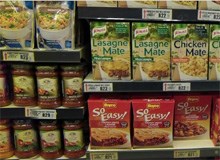The future of category management

Although category management lacks a single definition, the general feeling is that it can be summed up as: 'The strategic management of product categories as individual business units through retailer and supplier partnerships to maximise sales, increase profits and satisfy customer and shopper needs.'
The goal for category management is to organise a category of products, to satisfy customer and shopper needs and differentiate and present a product to shoppers in a manner that allows your brand to stand out on the cluttered shelves in a retail outlet.
The role of category management
Category management is an extensive process, but in the long run, the benefits are felt through increased sales for the retailer, increased profits for the supplier, increased customer basket size and shopper satisfaction. Its aim is to ensure that the product the customer wants is easy to find and available. For suppliers, becoming the category captain is the final destination for increased product sales and gaining increased shelf space and prime product positioning.
The industry standard model for category management in retail is a 9-step process, namely:
- Define the category (i.e. what products are included/excluded).
- Define the role of the category within the retailer.
- Assess the current performance.
- Set objectives and targets for the category.
- Devise an overall strategy.
- Devise specific tactics.
- Design and set out planograms for the category and all products within the category.
- Implementation of planograms and strategy.
- This step is one of review, which takes us back to step 1.
This process will allow your product to takes its place on the increasingly cluttered and highly competitive retail store shelves to face the customer and compete for attention. From here on it is up to marketing and in-store promotions to make your product stand out and be picked up by the shopper.
Traditional problems with implementation

Throughout the 9-step process, brand management has complete control of steps 1-7, to ensure the brand's strategic objectives are met. But control is lost in the most critical phase - implementation. You cannot be in every store in every area yourself and the implementation is often left to merchandisers who are not just looking after your product, but a range of products across various categories, which means focus is lost for your brand. Simply put, out of sight (of the consumer) means out of mind, and the critical importance of this is illustrated by Nielsen which observed that about 70% of purchase decisions are made in store.
I was recently introduced to a product called StoreVue, a solution I had never seen before and, in my opinion, will be a game changer for brands competing in the cluttered and competitive retail environment.
How StoreVue solves this

In today's fiercely competitive market simply knowing your forward share is just not good enough anymore. What is the reality of the trading environment? StoreVue records all the vital information from stores, shelf layouts, promotional activities and entire categories in hi-res images for you and your product team to access from your desktop. This allows you the control to see what is happening in the stores you can't be at in person. Reality checked. Consider it Google Maps for your retail environment. Here are the questions StoreVue can help you answer from your desk top:
- Where on shelf is my brand? Eye level may be desirable for detergents, but you want to be on a lower shelf with an impulse buy like sweets and chocolates that appeals to children
- Who is next to me?
- How impactful is my display?
- Do I stand out from the clutter when seen in the reality of the trading environment?
- Next to what category is my product? If you are selling pasta sauces, surely you want to be next to pastas, not in the sauces and condiments aisle?
- Similarly, canned tomatoes could be cross merchandised in the pasta aisle to induce trial.
StoreVue also answers the questions of:
- Are the planograms being followed and is my promotional activity actually in store and set up correctly?
- Are promotional displays actually erected?
- Are the shelf strips and pack glorifiers accurately placed?
- What is the condition of POS material? Surely a premium brand display with sub premium execution will adversely affect the brand health indicators, at exactly the place where it really matters, thereby negating the huge investment in advertising. Brand building is not the soul domain of advertising.
- What are my competitors doing in store, not only promotional activity, where did they place the new SKU and with how many facings?
In essence critical basic information is not available to brand and category management. The entire process of category management is all about the details. StoreVue gives you the details in the hi-res images, taking the maybe out of category management and giving you the facts.
To find out more about StoreVue, go to www.storevue.co.za or email az.oc.euverots@ofni.












